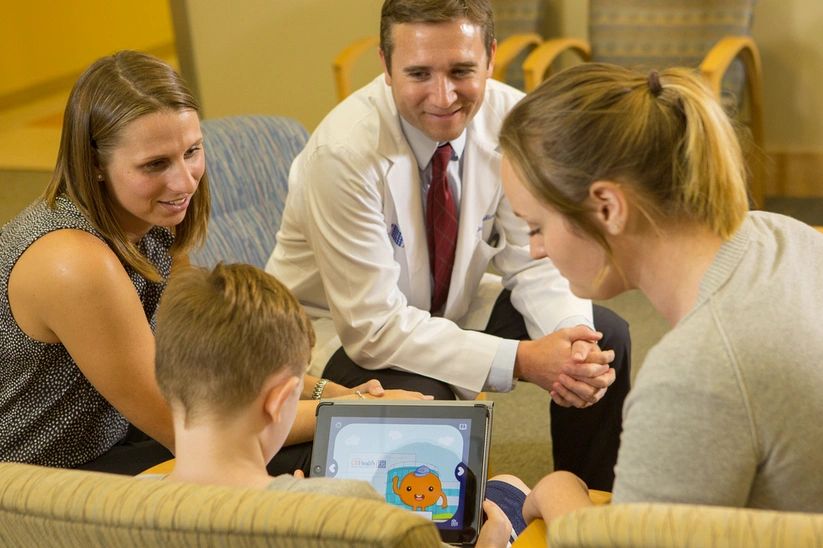
Branding | UX Research | Product Design | mHealth
Proton U
A mobile application to help pediatric cancer patients and their families learn about their upcoming treatment at the the University of Florida Health Proton Therapy Institute (UFHPTI).
The Design Challenge
PROBLEM STATEMENT
GOALS & OBJECTIVES
GOALS & OBJECTIVES
Pediatric cancer patients, ranging in age from 18 months old to 18 years old, go to UFHPTI for 6 weeks of treatment. They come to Jacksonville, FL from other states and countries, including Great Britain, Norway, Peru, Saudi Arabia, China, Nicaragua and Australia. Upon arrival, some patients have little to no knowledge of proton therapy.
GOALS & OBJECTIVES
GOALS & OBJECTIVES
GOALS & OBJECTIVES
Prepare pediatric cancer patients for their upcoming treatment. Equip young patients with information and coping skills that may reduce anxiety and fear during a stressful time in their lives. Collaborate with a mobile developer to create an interactive storybook app for children to learn about proton therapy.
User Research
CONTEXTUAL INQUIRY
CONTEXTUAL INQUIRY
CONTEXTUAL INQUIRY

The design team visited the institute, toured facilities and met with families. The observations and semi-structured interviews helped us learn about proton therapy and develop empathy with users.
PERSONAS
CONTEXTUAL INQUIRY
CONTEXTUAL INQUIRY

I worked with a Child Life Specialist to develop personas based on her experience with patients. We used these throughout the project to consider different types of users when making design decisions.
Concept Development
BRANDING

The concept is intended to be both educational and entertaining for kids. Proton U is a virtual prep school that users attend to learn about proton therapy.
THE MAIN CHARACTER

The main character is a round, orange, anthropomorphic proton. He’s the orange dot in the UFHPTI logo. His name is Jefferson because the institute is on Jefferson St.
How We Worked
THE DESIGN TEAM
THE DESIGN TEAM
THE DESIGN TEAM

Students applied for “jobs” related to illustration / character design, UX / content development, and branding / UI design. As the professor overseeing design, my role involved creative direction and project management. I coordinated communication between the medical team, designers and developers.
SAMPLE SCREENS
THE DESIGN TEAM
THE DESIGN TEAM

The app starts by welcoming users to the institute. Jefferson introduces users to the medical team and is their sidekick in each section. Users make a few items for Jefferson that they will soon need for themselves during treatment. The app helps to familiarize users with the sights and sounds in various rooms.
VOICE ACTORS
VOICE ACTORS
VOICE ACTORS

Theatre students auditioned to be the characters’ voices, and communication students volunteered to record audio at the on-campus radio station.
TRANSLATORS
VOICE ACTORS
VOICE ACTORS

Language students translated content to Spanish and Norwegian to make the app more accessible for international patient families.
User Experience
TOUCHPOINTS
After working on the app for a few months, the team reframed the problem at the systems-level. We thought about the whole user experience – before treatment, when children first arrive at the institute, and during their treatment. As a result, we developed a suite of interrelated products for each touchpoint.

Interrelated Products
PRINTED STORYBOOK
PRINTED STORYBOOK
PRINTED STORYBOOK

In addition to the mobile app, a printed storybook was produced. It can be mailed to patients who don't have access to a mobile device at home.
CARDBOARD CUTOUT
PRINTED STORYBOOK
PRINTED STORYBOOK

A life-size cardboard cutout of Jefferson is on display in the lobby. He welcomes patients to the institute and reminds them to download the app.
PLUSH TOY
PRINTED STORYBOOK
PLUSH TOY

A plush toy-version of Jefferson is intended to comfort children during their treatment. Other products include coloring pages and a certificate of completion.
The Impact
RESULTS
The app was developed and tested in 2016 and launched in early 2017. The medical team at UFHPTI has incorporated the app into their active pediatric program, which is one of the largest in the world. The program has dramatically improved the rates of children requiring daily anesthesia for treatment – dropping from 94% to 50% in children age five to seven.
The project was honored with a Campus Community Partnership award from Florida Campus Compact and made the shortlist for the IxDA Interaction Awards.
Copyright © 2025 Natalie W. Stephenson - All Rights Reserved.